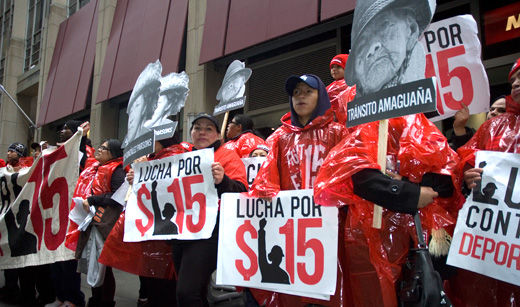
The National Employment Law Project recently issued an analysis of the economic recovery from the 2008 recession (more like a depression, now four years long, according to government economists) that shows a devastating loss of middle-income jobs and job “growth” almost entirely in low paying food and other service sectors.
According to NELP, employment losses occurred throughout the economy, “but were concentrated in mid-wage and higher-wage industries. By contrast, during the [so-called] recovery (measured from February 2010 to February 2014), employment gains have been concentrated in lower-wage industries. Lower-wage industries constituted 22 percent of recession losses, but 44 percent of recovery growth. Middle-wage industries constituted 37 percent of recession losses, but only 26 percent of recovery growth. Higher-wage industries constituted 41 percent of recession losses, and 30 percent of recovery growth.”
Today, there are nearly two million fewer jobs in mid- and higher-wage industries than there were before the recession took hold, while there are 1.85 million more jobs in lower-wage industries.
Sectors such as food services, bars, and retail trade have led private sector job growth during the recovery. Many of these industries pay poverty wages, and accounted for 39 percent of the private sector employment increase over the past four years.
The prevalence of low wage over middle and upper income jobs in this recovery contrasts sharply with the recovery character of the 2001 recession after the tech bubble burst. In the 2001 recession, lower- and higher-wage industries led the recovery, accounting for 39 and 40 percent of employment gains, respectively. Mid-wage industries added jobs at just over half the rate of lower- and higher-paying industries.
In the 2008 depression, employment growth is more concentrated in lower-wage industries where private sector employment grew by over 10 percent. Job growth in absolute numbers is slightly stronger in mid-wage industries relative to the earlier recovery; however, initial job losses were also much more severe this time. The share of net job growth accounted for by higher-wage industries declined from 40 percent following the 2001 recession to only 30 percent over the recent recovery.
One year into the recovery, slow growth in higher-wage industries was likely the result of specific drivers of the Great Recession, such as the housing bubble and the financial crisis. In addition, however, the depression appears to have accelerated a continuation of the long-term decline in durable and nondurable manufacturing and telecommunications.
Three years later, mid- and higher-wage industries are adding some jobs; but not at rate to fill the job deficits in these income brackets. Four years into the recovery, growth remains strongest in low-wage retail, restaurants, and temporary help. The only other relief comes from occupations and industries less affected by depression (e.g., health and education).
Over the past four years, even the low-wage weighted private sectors gains have been partially negated by public sector job losses resulting from budget cuts at federal, state, and local levels. Net job losses totaled 627,000 across all levels of government during the recovery period. Employment declines were particularly severe at the local level, where education absorbed nearly three-quarters of the 378,000 net job losses over the past four years.
What are the reasons for the trends toward low wage jobs?
The number one reason is globalization. There is currently no international or governmental force that can regulate or compensate for the ability of transnational corporations to move jobs to the lowest acceptable labor market, whether it is in a depressed, income-starved state, or a newly industrializing country. Globalization has the same overall effect on corporate incentives to keep wages low, as the absence of wage and hour protection, safety, child labor prohibition, slave labor prohibition, or union protection have: Globally, nothing stops the intensification of labor exploitation.
The second reason is the main capitalist economies of the world-with the United States in the lead – have seen a dramatic increase in the so-called wealth gap. Not only is the top 1 percent many times richer than the rest of the world – big corporations with banks, hedge funds and financial institutions in the first place – are hoarding their ill-gotten assets, choosing to invest in the greatest get-rich-quick scheme they can find.
That is why a 21st century economy – one that supports rising incomes and reverses this trend – must make investments in green industrial policy, infrastructure and human capital, on a scale even greater than the Roosevelt New Deal and World War II mobilization, which massively transformed the U.S. industrial base and lifted its productivity for over a generation. Markets won’t do this. Only governments can. Especially if they are equipped with tools like a progressive tax-the-rich policy and commitment to clean energy. Which is why the ultra-right billionaires in the U.S. – like the oil baron Koch brothers – are doing everything in their power to nullify the authority of government to serve the governed.
Photo: May Day 2014 in Chicago. Earchiel Johnson/PW

MOST POPULAR TODAY


Communist Karol Cariola elected president of Chile’s legislature

Zionist organizations leading campaign to stop ceasefire resolutions in D.C. area

Afghanistan’s socialist years: The promising future killed off by U.S. imperialism

High Court essentially bans demonstrations, freedom of assembly in Deep South






Comments